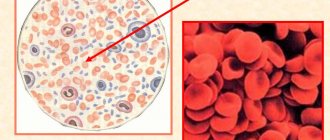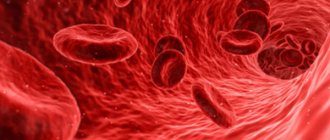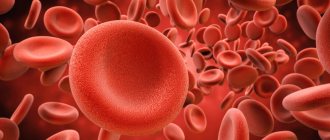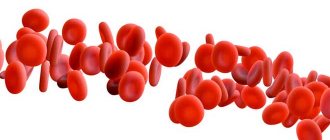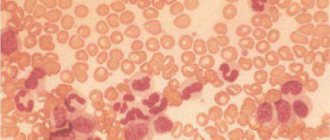The erythrocyte index is measured in femtoliters or micrometers cubed. The formula used for calculation is: the ratio of the volumes of all red blood cells to their number. MCV is calculated automatically. The formed elements of blood vary in size and volume, therefore, to diagnose blood diseases, the average cellular volume is determined. For diseases associated with changes in the shape of the red blood cell, the indicator is unreliable.
The indicator is unstable and varies with age. For newborns - 112 fl. After a year, the child’s red blood cell volume decreases to 77–79 fl. In adults, the normal MCV is 80 – 100 fL. A change in value above normal is called macrocytosis; below - microcytosis. Normocytosis is the average volume of red blood cells within the age range.
Why is MCV decreasing?
One of the reasons for a decrease in the volume of blood cells is an electrolyte imbalance. An increase in sodium ions leads to hypertonic dehydration - this is the main cause of dehydration in the body. Lack of fluid reduces the volume of cell cytoplasm. The volume of red blood cells decreases in the following diseases:
- Hemoglobinopathy is a disorder of hemoglobin formation.
- Disturbance of protein metabolism – lack of protein causes defects in the structure of red blood cells.
- Congenital pathologies – thalassemia.
- Lead poisoning.
- Alcohol intoxication.
The indicator plays an important role in the diagnosis of hematological diseases. A decrease in red blood cells leads to the development of microcytic anemia. There are several types of such diseases.
Reduced value
If the average volume is reduced, they speak of anemia, i.e. a lack of hemoglobin in the blood.
The most common reasons when red blood cells are below normal are:
- Iron deficiency or iron deficiency anemia. This form of anemia occurs without complications and has the simplest treatment compared to other types of anemia. If a child’s hemoglobin is low and the cause is determined to be iron deficiency, the child is prescribed a special diet with a repeat blood test a month later. If a child’s hemoglobin does not increase after a month, but rather decreases, then in this case, he is referred to a hematologist and drug treatment is prescribed.
- Sideroblastic anemia. Also associated with iron deficiency, responds well to vitamin B6 therapy. This type of anemia develops quite rapidly and requires immediate action; the worst outcome of such a diagnosis can be death.
- alassemia is a genetic disease. Anemia is caused by impaired hemoglobin production.
- Lead poisoning. In case of lead poisoning, the average value of red blood cells decreases due to the fact that the bone marrow begins to fail and a disruption occurs in the body's production of hemoglobin.
- Dehydration of the body. This is due to the loss of fluid from the body, which negatively affects the blood test.
Sometimes there are situations when the average volume of red blood cells is not reduced, but is within the normal range, but clear signs of anemia appear. This often happens if there is:
- the presence of a malignant tumor,
- the presence of chronic infections,
- significant blood loss
- the presence of diseases that cause insufficient production of hormones.
If the mcv is lowered in the analysis, then a qualified consultation with the attending physician or hematologist is necessary.
Sideroblastic anemia
Impaired hemoglobin synthesis as a result of a deficiency of proporphyrins and insufficient absorption of vitamin B6 in the intestine. As a result, abnormal erythroblasts are formed. Under a microscope, they are visually identified as abnormal cells with iron inclusions in the cytoplasm. Defective red blood cells are reduced in size.
Mass hemolysis with a critical decrease in formed elements is possible. The condition requires emergency medical attention.
If a child has low hemoglobin, what does this mean?
Many children experience anemia. Although more often newborn children suffer from this, since mothers experienced anemia during pregnancy. In a newborn baby, the concentration of corpuscles is always increased, but then it decreases.
When a child has poor nutrition, little vitamin food, and he rarely gets outdoors, even a healthy person can develop anemia. When this happens, first pay attention to the child's nutrition and walking routine.
There is such an indicator as MCSU. It determines the average hemoglobin level in red blood cells. MCHC reflects the concentration of hemoglobin in red blood cells. What amount of hemoglobin in the entire cell volume is reflected by MSHC. MSHC analysis indicators are used in the diagnosis of any anemia. MCHC is reflected in g/l.
If your MSHC is low, you may:
- The number of red blood cells is greater than their saturation with hemoglobin.
- If hemoglobin synthesis is impaired, then the disease is hemoglobinopathy.
- Water-electrolyte metabolism has disturbances.
- You have iron deficiency anemia.
- You have thalassemia.
Indications for MCV analysis
Determination of red blood cell volume is included in standard tests. Blood is taken from a finger or vein, preferably on an empty stomach. Prescribed for the following disorders:
- with electrolyte imbalance;
- for differential diagnosis in hematology;
- for metabolic diseases;
- for chronic endocrine diseases.
This indicator can be used to determine the type of dehydration. A decrease in red blood cell volume indicates a decrease in fluid in the tissues due to an increase in the concentration of potassium ions in the blood.
Generally accepted standards
The average MCV rate for adults: 80-100 femtoliters - such a red blood cell is considered normal.
- If the numbers are below normal, then microcytosis is diagnosed.
- If the result exceeds the specified value, then macrocytosis develops.
The average volume of red blood cells in the blood is not constant; it changes throughout a person’s life. Below is a table of normal reference values for boys and girls under 12 years of age.
In adolescents during puberty and in adults, MCV in a blood test depends not only on age, but also on gender.
As can be seen from the tables, MCV in the analysis changes slightly and almost always fits into the average norm of 80-100 fl.
In pregnant women, many hemolytic data change during pregnancy, but the size of red blood cells remains the same. Deviation from generally accepted norms indicates a pathology of pregnancy.
Decoding the results
MCV analysis is performed in a clinic, inpatient departments or in laboratories. Based on the data, the doctor makes a conclusion about the state of the hematopoietic system, the degree and type of dehydration of the patient. If the results are questionable, a repeat test is prescribed. If the analysis is performed automatically, the results are more accurate. Normal numbers indicate anemia in the following diseases:
- with bleeding;
- with liver failure;
- with hemolysis;
- with pathology of the thyroid gland.
Macrocytic indicators indicate anemia caused by deficiency of B vitamins and malignant tumors, endogenous intoxication and myxedema. Deviation from the norm occurs in smokers and women taking oral contraceptives. The diagnosis of the disease and the choice of treatment regimen depend on the correct analysis. Repeated research is necessary to monitor and correct therapy.
Reasons for deviations from the norm
The average volume of red blood cells in children or adults may fluctuate up or down, which in any case indicates the occurrence of some pathological process.
For example, when the mean red blood cell volume is elevated, a person may be diagnosed with one of the following:
- severe poisoning from chemicals or poor-quality food;
- thyroid dysfunction and other pathologies of the endocrine system;
- deficiency of iodine or iron in the body;
- reticulocytosis;
- liver pathologies, in particular hepatitis and cirrhosis;
- cancer of the bone marrow;
- celiac disease;
- DiGuglielmo's disease;
- hypothyroidism;
- hyperglycemia;
- infection or inflammation in the pancreas;
- myelodysplastic syndrome;
- chronic liver failure.
If mcv is elevated, then this does not always indicate the course of the disease, for example, among the less harmless sources are:
- sedentary lifestyle;
- poor nutrition;
- uncontrolled use of medications;
- long-term addiction to bad habits;
- specific working conditions, for example, under which a person is forced to constantly come into contact with toxins;
- hormonal imbalance that develops during menstruation or pregnancy.
If a general clinical blood test shows that the average volume of red blood cells is reduced, this may indicate:
- various types of anemia;
- formation of malignant neoplasms;
- heavy metal intoxication;
- thalassemia;
- leukemia;
- heavy blood loss;
- metastasis of malignant tumors;
- porphyria;
- autoimmune diseases.
Also, the indicator can be reduced due to abuse of the following medications:
- "Isoniazid";
- "Colchicine";
- "Metformin";
- "Phenacetin";
- "Trimethoprim";
- "Methotrexate";
- "Pyrimethamine";
- "Triamterene";
- "Glutethimide";
- mefenamic acid;
- estrogens;
- oral contraceptives;
- nitrofurans;
- anticonvulsants;
- aminosalicylic acid.
In some situations, the average volume of red blood cells mcv remains within the normal range, but a person may experience:
- normocytic anemia;
- hemoglobinopathy;
- pathologies of the hematopoietic system;
- hypogonadism;
- hypopituitarism;
- hypoadrenalism;
- hypothyroidism;
- chronic infectious processes;
- uremia.
Treatment when the average volume, corpuscles are reduced
After taking a general blood test, you were found to have a decreased volume of red blood cells. There is no need to worry right away, just contact a specialist. He will determine the cause of the disease and prescribe the necessary treatment. When inflammation occurs in the body or an infection is present, the doctor will prescribe treatment with vitamins and immunostimulants.
If you have overhydration, the specialist will prescribe diuretics or even a special diet that will help retain fluid in the cells. Severe blood loss is being restored thanks to emergency measures taken at the hospital. If the diseases are more serious, they are treated on an outpatient basis under the strict supervision of a doctor. Such measures are taken in case of cancer and serious anemia.
- lungwort;
- burnet roots;
- wild strawberry leaves;
- chokeberry berries;
- dog-rose fruit.
Strawberry leaves are enriched with iron, copper, riboflavin, manganese and organic acids. All this causes a hemostimulating effect on the body. 1 tbsp. Pour 250 ml of boiling water over a spoonful of crushed leaves. Leave for 1.5 hours and then consume 0.5 cups per day. Take the decoction for three months.
You can make a vitamin mix. Mix chokeberry, rose hips and strawberries, a tablespoon each. Pour half a liter of boiling water into this mixture into a thermos and drink three times a day after meals.
The blood cells are low, then drink this decoction of lungwort leaves. 1 tbsp. Brew 1 teaspoon of this herb and nettle with one glass of boiling water. Let it brew for half an hour and drink 1/3, 3 times a day after meals, after 60 minutes.
Follow our recommendations and you will always be healthy.
The normal average volume of red blood cells can be restored only after the underlying disorder has been eliminated. In some cases, for correction it is enough:
- to refuse from bad habits;
- reconsider food preferences;
- Do not take medications for no apparent reason or without a doctor’s prescription.
In other situations, you should completely get rid of the underlying disorder, which can be done with the help of:
- taking medications;
- physiotherapeutic procedures;
- diet therapy;
- the use of non-traditional treatment methods;
- surgical intervention.
Treatment tactics are selected individually for each person in accordance with the mechanism of development of a violation of the average volume of red blood cells.
